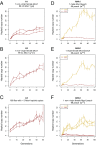Experimental evolution reveals hyperparasitic interactions among transposable elements
- PMID: 27930288
- PMCID: PMC5187678
- DOI: 10.1073/pnas.1524143113
Experimental evolution reveals hyperparasitic interactions among transposable elements
Abstract
Transposable elements (TEs) are repeated DNA sequences that can constitute a substantial part of genomes. Studying TEs' activity, interactions, and accumulation dynamics is thus of major interest to understand genome evolution. Here, we describe the transposition dynamics of cut-and-paste mariner elements during experimental (short- and longer-term) evolution in Drosophila melanogaster Flies with autonomous and nonautonomous mariner copies were introduced in populations containing no active mariner, and TE accumulation was tracked by quantitative PCR for up to 100 generations. Our results demonstrate that (i) active mariner elements are highly invasive and characterized by an elevated transposition rate, confirming their capacity to spread in populations, as predicted by the "selfish-DNA" mechanism; (ii) nonautonomous copies act as parasites of autonomous mariner elements by hijacking the transposition machinery produced by active mariner, which can be considered as a case of hyperparasitism; (iii) this behavior resulted in a failure of active copies to amplify which systematically drove the whole family to extinction in less than 100 generations. This study nicely illustrates how the presence of transposition-competitive variants can deeply impair TE dynamics and gives clues to the extraordinary diversity of TE evolutionary histories observed in genomes.
Keywords: Drosophila; experimental evolution; hyperparasitism; invasion dynamics; transposable elements.
Conflict of interest statement
The authors declare no conflict of interest.
Figures



References
-
- Ågren JA, Wright SI. Co-evolution between transposable elements and their hosts: A major factor in genome size evolution? Chromosome Res. 2011;19(6):777–786. - PubMed
-
- Hua-Van A, Le Rouzic A, Maisonhaute C, Capy P. Abundance, distribution and dynamics of retrotransposable elements and transposons: Similarities and differences. Cytogenet Genome Res. 2005;110(1–4):426–440. - PubMed
-
- Lynch M, Conery JS. The origins of genome complexity. Science. 2003;302(5649):1401–1404. - PubMed
-
- Doolittle WF, Sapienza C. Selfish genes, the phenotype paradigm and genome evolution. Nature. 1980;284(5757):601–603. - PubMed
-
- Orgel LE, Crick FH. Selfish DNA: The ultimate parasite. Nature. 1980;284(5757):604–607. - PubMed
MeSH terms
Substances
LinkOut - more resources
Full Text Sources
Other Literature Sources
Molecular Biology Databases

